THE 10.5 WIDE ISSUE
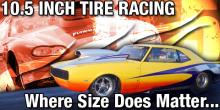 Back in 1993 I was editor of the old National Muscle Car Association’s
magazine. I still recall walking through the pits of the Fastest Street
Car Shootout in Memphis and smelling fresh rubber as competitors filed
their Super Street tires down until they put down a 10 and half-inch
footprint. We were certainly strict back then, but this dramatically
illustrates a problem that has once again cropped up in today’s 10.5
classes.
Back in 1993 I was editor of the old National Muscle Car Association’s
magazine. I still recall walking through the pits of the Fastest Street
Car Shootout in Memphis and smelling fresh rubber as competitors filed
their Super Street tires down until they put down a 10 and half-inch
footprint. We were certainly strict back then, but this dramatically
illustrates a problem that has once again cropped up in today’s 10.5
classes. Super Street started off as a companion class to the NMCA’s Pro Street category, loosely based on the Outlaw Super Stocks that ran out of the Chicago area back then. The distinguishing factor was the small tires they utilized, which were limited to a 10.5-inch width. The class quickly took on a legendary status as these 3000 lb. cars dropped from 9 to 8, then to 7-second elapsed times. But controversy arose over the actual footprint of the slicks. How close should you adhere to the tire’s original 10.5 inches? At what point in a tire’s lifespan do you measure its width--fresh out of the mold, off the car, on the car, before a race or after? How do you measure it? What do you measure it with?
All of a sudden...size matters
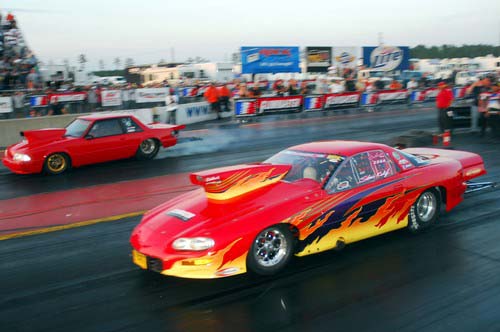
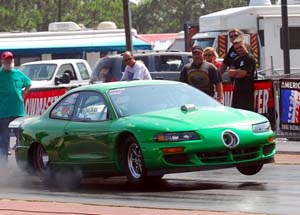 Back in 1993 I was editor of the old National Muscle Car Association’s magazine. I still recall walking through the pits of the Fastest Street Car Shootout in Memphis and smelling fresh rubber as competitors filed their Super Street tires down until they put down a 10 and half-inch footprint. We were certainly strict back then, but this dramatically illustrates a problem that has once again cropped up in today’s 10.5 classes.
Back in 1993 I was editor of the old National Muscle Car Association’s magazine. I still recall walking through the pits of the Fastest Street Car Shootout in Memphis and smelling fresh rubber as competitors filed their Super Street tires down until they put down a 10 and half-inch footprint. We were certainly strict back then, but this dramatically illustrates a problem that has once again cropped up in today’s 10.5 classes.
Super Street started off as a companion class to the NMCA’s Pro Street category, loosely based on the Outlaw Super Stocks that ran out of the Chicago area back then. The distinguishing factor was the small tires they utilized, which were limited to a 10.5-inch width. The class quickly took on a legendary status as these 3000 lb. cars dropped from 9 to 8, then to 7-second elapsed times. But controversy arose over the actual footprint of the slicks. How close should you adhere to the tire’s original 10.5 inches? At what point in a tire’s lifespan do you measure its width--fresh out of the mold, off the car, on the car, before a race or after? How do you measure it? What do you measure it with?
Tire shaving continued in the NMCA until Mickey Thompson Tires began manufacturing tires exclusively for street-legal competition. This first purpose-built tire was designated the 31/10.5 W. It was wider by an extra inch, making the footprint nearly 11.5 inches. “I think it was the biggest small tire that we had,” recalled Carl Robinson, head of Mickey Thompson’s Motorsports Division. “It would fit on most cars without modifying the stock suspension.” By 1999 M/T had released a 33-inch tall W tire, which pretty much became ‘coin of the realm’ for Outlaw Street racers. Not till other tire companies started making 33/10.5s did things begin to become controversial again, especially after Hoosier Tire entered the fray last March.
Last August class top runner Steve Kirk used the new Hoosiers at an American Drag Racing League (ADRL) event in Rockingham, North Carolina, and he scorching the track with a record-setting 4.43-second elapsed time in the eighth-mile.
“It happened that with the weight of these cars and the way the tires are built, our tire is just a little bit wider than the one Mickey Thompson has out there,” explained Faron Lubbers, Product Manager for Hoosier's drag racing line. “We actually tried to match their tire when we built ours. Ours would go 12 inches or maybe just a little bit over depending how many runs you had on them. We weren’t trying to cheat or make anything super wide. We were just trying to match the size that the Mickey was. We got pretty close. Because we were a little wider, we got a lot of flack over us trying to ruin the class. That’s ridiculous--this is our business; why would we try to ruin (a market)? We want to help it grow.”
a d v e r t i s e m e n t
Click to visit our sponsor's website
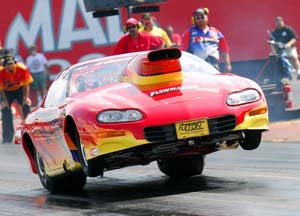 Mickey Thompson’s Robinson cited that this particular Hoosier tire’s
rollout area was also bigger. “Rollout equals contact patch, basically
the circumference of the tire,” he said. “I sincerely believe that
rollout is an even bigger factor than the tread. The taller you make
them, the better they work. (Hoosier’s) rollout was 107 inches. Ours
are between 101.5 and 103 inches. Do the math: divide 107 by 3.14 [the
value of pi]: that’s about a 34-inch tire. That’s 21.7 square inches
more contact patch than our tire. The 10.5W class has always been an
11.2-inch tire. (Our) tire hasn‘t been changed in any dimension since
2002. This forced the sanctioning bodies to decide whether we were
going to have a 10.5W class or Junior Pro Mod.”
Mickey Thompson’s Robinson cited that this particular Hoosier tire’s
rollout area was also bigger. “Rollout equals contact patch, basically
the circumference of the tire,” he said. “I sincerely believe that
rollout is an even bigger factor than the tread. The taller you make
them, the better they work. (Hoosier’s) rollout was 107 inches. Ours
are between 101.5 and 103 inches. Do the math: divide 107 by 3.14 [the
value of pi]: that’s about a 34-inch tire. That’s 21.7 square inches
more contact patch than our tire. The 10.5W class has always been an
11.2-inch tire. (Our) tire hasn‘t been changed in any dimension since
2002. This forced the sanctioning bodies to decide whether we were
going to have a 10.5W class or Junior Pro Mod.”
Johnny Finn’s Outlaw Racing Street Car Association (ORSCA), one of the leading sanctions for small tire racing, responded last year by setting the maximum width at 12 inches.
“We never had a problem with it before because it was just one tire company,” said Finn. “Now there’s Goodyear, Hoosier, Toyo, and probably a few others looking at this tire because it’s a money-making deal. We were afraid that pretty soon we were going to be still calling it 10.5 and we would all be racing on 14/32 tires.”The issue was settled at 12 inches. That is until ADRL president Kenny Nowling spoke up during a series of meetings held last November at the PRI show in Orlando, Florida.
“(ADRL) felt like the class was becoming somewhat stagnant,” Nowling said. “There weren’t a lot of guys building cars, the Outlaw 10.5 specifically. By their own admission, some of the other organizations were seeing lower car counts and so forth.”
The meetings were attended by most of the leading 10.5 sanctioning bodies, such as ORSCA, ADRL, NMRA/NMCA, and the West Coast-based Pro Street Car Association. Tire manufacturers Mickey Thompson, Hoosier and Goodyear were also involved, as were a number of racers. Nowling outlined his plan to shake things up in the 10.5 world with the ADRL’s new Extreme 10.5 class. There would be no limitations on engines, no minimum weight, a maximum wheelbase of 115”, working mufflers, stock appearance with working headlights and taillights, and of primary concern to Nowling, true 10.5W tires.
“I don’t want to mislead my public, the sponsors, or the spectators,“ Nowling said. “If we’re going to use ’10.5’ in the title of the class, I want to at least get close to that number. My feeling was that 11 was the right number. Now I didn’t have the most educated opinion at that table, but I wanted to get it back because I thought it was going to create two things; a more entertaining class and a more level playing field for the competitors.”
a d v e r t i s e m e n t
Click to visit our sponsor's website
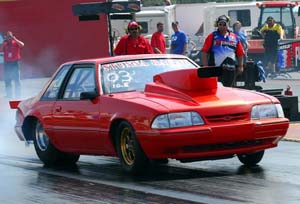 “(Nowling) wanted the cars wild and crazy, all over the track,”
commented Johnny Finn. “Everybody kind of looked at their $300,000
Outlaw cars and said, ‘not with my car.’ Besides, ORSCA has a class for
that called Limited Street, on a true 29/10.5 tire, no wheelie bars,
and they’re as wild and crazy as you can be. We weren’t willing to back
up and kill a class just because somebody wanted to do something a
little different.”
“(Nowling) wanted the cars wild and crazy, all over the track,”
commented Johnny Finn. “Everybody kind of looked at their $300,000
Outlaw cars and said, ‘not with my car.’ Besides, ORSCA has a class for
that called Limited Street, on a true 29/10.5 tire, no wheelie bars,
and they’re as wild and crazy as you can be. We weren’t willing to back
up and kill a class just because somebody wanted to do something a
little different.”
Eventually a compromise was reached. The sanctioning bodies would allow 12-inch tires until June 1st, when the limit would drop to 11.5 and a maximum rollout of 105, regardless of temperature or wear, as measured with the vehicle off the ground at 8 lbs. of air pressure. The grace period would give the tire makers time to sell their current 12-inch inventory. But then there are those pesky questions once again.
“Because of the nature of a bias-ply tire, they can be stretched and made into a much bigger tire than they originated as,” said Robinson. “I came to some conclusions with (the sanctioning bodies); there are gauges which can be made, like a go/no-go gauge which is a relatively quick way to observe the tread width. But measuring the circumference of the tire, you’ve got to jack the car up and put a ruler on it. Any time there was a race won or a record set, I would think that this would be one more process that has to happen at the scales. That‘s my suggestion if they want to keep the integrity of 10.5 Outlaw racing.”
“We’re not going to chase these cars up and down the track with rolling jacks to check the tires,” said Finn. “There’s a danger factor. We’re going to do it in tech because that’s the only place you can measure them. Now if we set a record, we’re going to measure that tire and make sure that it’s a legit tire.”
a d v e r t i s e m e n t
Click to visit our sponsor's website
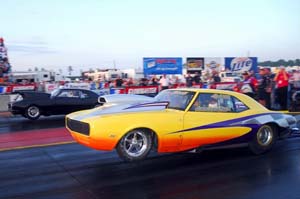 “We’re a racing tire company, and that’s one area in drag racing that we hadn’t attacked. When we did, it was like poking a big stick in a hornets nest,” said Hoosier’s Lubbers. “We’ve had a real education on this in the last couple of months. When we built this tire it was 11 inches wide. These 10.5 guys run them on 15 and 16-inch wide bead lock wheels, so by the time you put the tire on these big wheels and air it up, the tire goes almost to 11 and a half. Set the car weight down on it and it widens another quarter of an inch. Run it--even more. (But) whatever the rule is, we’ll abide by that rule and we’ll go out and try to beat whatever other tire company wants to get involved. We have to do our job the best possible way to have that performance edge.”
“We’re a racing tire company, and that’s one area in drag racing that we hadn’t attacked. When we did, it was like poking a big stick in a hornets nest,” said Hoosier’s Lubbers. “We’ve had a real education on this in the last couple of months. When we built this tire it was 11 inches wide. These 10.5 guys run them on 15 and 16-inch wide bead lock wheels, so by the time you put the tire on these big wheels and air it up, the tire goes almost to 11 and a half. Set the car weight down on it and it widens another quarter of an inch. Run it--even more. (But) whatever the rule is, we’ll abide by that rule and we’ll go out and try to beat whatever other tire company wants to get involved. We have to do our job the best possible way to have that performance edge.”
In response to Hoosier’s challenge, Mickey Thompson plans on doing more with contingency programs. “As it turns out, the new tire spec is going to be exactly what our tire is. We don’t have to change anything,” said Robinson. “We’ve been the de facto tire for the class, but we didn’t go out and buy the rights to it, we earned it with quality products and good service, and we want to step that up. We’re doing what we can to maintain as much market share as possible. We’re supporting more and more racers every year. It’s not that we don’t want competition. What we’re against is not having a level playing field. I’ll compete with (other tire makers) any day of the week on a tire that’s the same size.”
Now as the competition in all of the 10.5W classes heats up this spring, not only will we be watching the racers, but the tire makers too.
| {loadposition feedback} |





